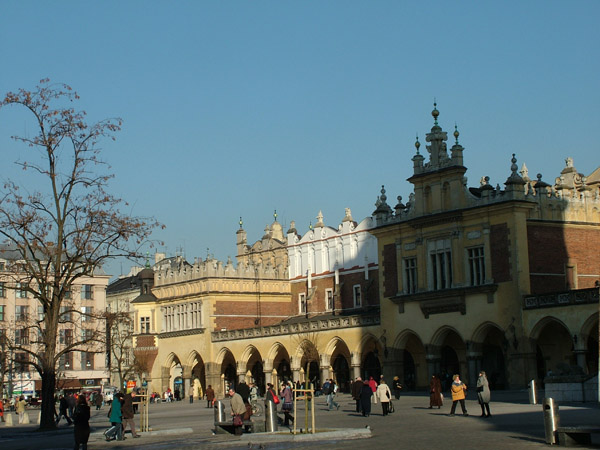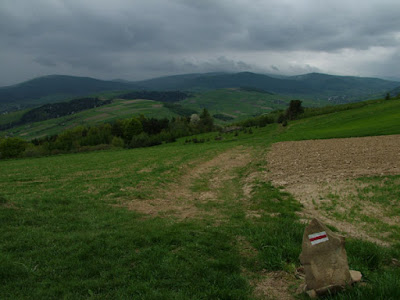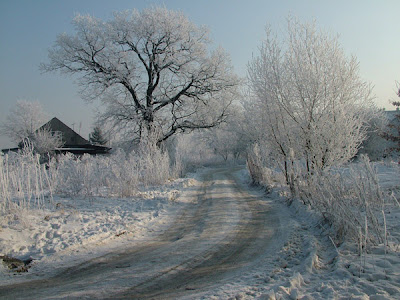Yes, yes, we all live well and are quite busy. What are we doing? Cooking, feeding, baking, eating, boiling, consuming, having photos and having fun! Yum, yum, yum! Many of you already know my ANZAC biscuits. In print soon. Keep awaited!
2012-11-26
2012-10-16
World Bread Day
 Walking down Nowy Swiat Street in Warsaw I met a small stand in front of one of the bakeries. Smiling young people were serving pieces of their breads with pesto, tapenade and mushroom paste. All was arranged around one-meter tall bread Eiffel tower! Do you remember the bread Eiffel Tower in Peter Mayle's Confessions of a French Baker? The Warsaw bread tower was also impressing. Congratulations, guys!
Walking down Nowy Swiat Street in Warsaw I met a small stand in front of one of the bakeries. Smiling young people were serving pieces of their breads with pesto, tapenade and mushroom paste. All was arranged around one-meter tall bread Eiffel tower! Do you remember the bread Eiffel Tower in Peter Mayle's Confessions of a French Baker? The Warsaw bread tower was also impressing. Congratulations, guys!
I have no time for baking now so I celebrate the World Bread Day with memories from the fantastic food festval in Gruczno, Poland. The Food Festival in Gruczno takes place from 2006. Planning your trip to Poland make sure you won't miss this event in August.
 |
| Handmade simple bread in historic style |
2012-09-19
Polish pickled cucumbers - kiszone ogórki
 Never mind how busy you are in late summer - even a headchef must find time for pickling cucumbers! These are one of our favourites served as vegetable especially with roast beef or on canapes with pork lard - smalec. We pickle cucumbers in two ways. One, the most distinctive, is often referred to result in "spoiled' cucumbers that are sour because of the natural process. The vegetable becomes dark green and the water is mudding. They are also called salted cucumbers.The second pickling method is done thanks to vinegar - these cucumbers have transparent water and are brighter. The Polish usually are devoted to one favourite taste. I love pickled cucumbers with vinegar but my husband like naturally fermented cucumbers. So these are for him. All the fifty jars.
Never mind how busy you are in late summer - even a headchef must find time for pickling cucumbers! These are one of our favourites served as vegetable especially with roast beef or on canapes with pork lard - smalec. We pickle cucumbers in two ways. One, the most distinctive, is often referred to result in "spoiled' cucumbers that are sour because of the natural process. The vegetable becomes dark green and the water is mudding. They are also called salted cucumbers.The second pickling method is done thanks to vinegar - these cucumbers have transparent water and are brighter. The Polish usually are devoted to one favourite taste. I love pickled cucumbers with vinegar but my husband like naturally fermented cucumbers. So these are for him. All the fifty jars.  I use the recipe of my father, and his mother - my grandmother. I have found the same recipe in the oldest cookbook at my family home (the book that I already took over, secretly). The important thing is that cucumbers shall have no stains or scars. Choose the smallest as they will fit into the jar. They shall be pickled no more than 2-3 days after harvesting. It is always good to keep them in cold water over the night and then pickle. I found the soaking crucial if you don't want your cucumbers to be really spoiled. The old cookbook says that the good time for pickling is from the new moon up to the full moon.
I use the recipe of my father, and his mother - my grandmother. I have found the same recipe in the oldest cookbook at my family home (the book that I already took over, secretly). The important thing is that cucumbers shall have no stains or scars. Choose the smallest as they will fit into the jar. They shall be pickled no more than 2-3 days after harvesting. It is always good to keep them in cold water over the night and then pickle. I found the soaking crucial if you don't want your cucumbers to be really spoiled. The old cookbook says that the good time for pickling is from the new moon up to the full moon.
1 l water
1 kg small cucumbers
4-6 pepper grains
4-6 allspice grains
4 bay leaves
leaves of: vine, oak, blackcurrant, sour cherry
mature dill twig (it is big and stiff)
white horseradish root - 2 fingers size
4 garlic cloves
1.Soak small cucumbers overnight in cold water.
2. Boil the water with salt. Cool down completely.
3. Place in two 1-litre jars all the other ingredients.
4. Fit in cucumbers all around the edges and inside the jar.
5. Cover completely with salted water. Twist the jar really well.
6. Leave in a cold dark place. Watch for few days if no liquid comes out of the jar. If so - place a jar in a fridge, give it a week and then eat. Ballooned top of the jar is ok.
2012-06-03
Anardana and aniseed bread
 Oh Lord,
grant us enough time to bake and share the recipes! Baking was done, so here is
the recipe, only one of so many others done in Warsaw over the last year. The
inspiration came through an unusual Indian ingredient, Anardana powder, which
is powder of dried pomegranate seeds. This
recipe is shared especially for Mrs Elzbieta and her husband – a professional
home baker.
Oh Lord,
grant us enough time to bake and share the recipes! Baking was done, so here is
the recipe, only one of so many others done in Warsaw over the last year. The
inspiration came through an unusual Indian ingredient, Anardana powder, which
is powder of dried pomegranate seeds. This
recipe is shared especially for Mrs Elzbieta and her husband – a professional
home baker.
Anardana and aniseed bread
425 g
wheat flour
150 g
rye flour
100 corn
flour
2 Tbsp
oil
1 Tbsp
Anardana powder
1 tsp
aniseed
¾ Tbsp
salt
25 g
yeast
500
water
1. Mix
anardana powder, oil and yeasts with tepid water. Add to all the other
ingredients.
2. Knead
the dough until homogeneous and elastic. Form an oblong loaf, cover with a wet
cloth and forget for about 2 hours.
3. When the
bread doubles the size, put to the hot oven (180°) and bake for about 45
minutes. Check for the hollow sound. Place for another 10 minutes in the oven
if necessary. Cool down.
Enjoy
the exotic Eastern flavour of this filling bread!
2012-03-05
Hand made candies must-see in Warsaw
February is always the special month for me as I celebrate my birthday. This year my husband invited me for the candy and lollipop making show at the candy shop called "Manufaktura cukierków". The place is truly amazing and everyone visiting Warsaw should experience this.

 Then a skin for a candy.
Then a skin for a candy.
And you can cut warm candies which is done with quite a speed!
Then we've made lollipops, even the worst rascals kept focussed.
I have made the first true lollipop in my life. And we were both happy with Mr Waldemar.

The wonderful window display reminds of Christmas.
And the interior may be full of kids.
And sweets.
The gifted man behind the bar performing his show, working with hot caramel that becomes white and shiny.

First he formed a caramel pear.

Then you need plenty of hands for rolling, rolling, rolling...
Then we've made lollipops, even the worst rascals kept focussed.
I have made the first true lollipop in my life. And we were both happy with Mr Waldemar.

To stroke or to lick?
Manufaktura Cukierków
49 Tamka St
(entering from Ordynacka St)00-355 Warsaw
(entering from Ordynacka St)00-355 Warsaw
2012-02-29
Chocolate Piemontese Dessert in Warsaw
 What about an original Piemontese chocolate dessert, ideal for winter which still holds its reign in Poland? I invite to the Concept Restaurant where I currently play in the pastry section. Please let the service know that you are looking for me, this would be always a great pleasure to see you!
What about an original Piemontese chocolate dessert, ideal for winter which still holds its reign in Poland? I invite to the Concept Restaurant where I currently play in the pastry section. Please let the service know that you are looking for me, this would be always a great pleasure to see you!Its original name means a beret. For good luck you are supposed to consume it all, which is nevertheless any sort of problem.
2012-02-16
Polish cenci - Faworki
 Hello everyone! No, I didn't go out of the kitchen! In fact I couldn't do it for a long time so I decide to move my laptop to the kitchen. Now me, my kompot, bottom mushoom, coconut oil, pineapple, tomatoes, black turnips and other treasures that fill me with warmth are with me and we can follow.
Hello everyone! No, I didn't go out of the kitchen! In fact I couldn't do it for a long time so I decide to move my laptop to the kitchen. Now me, my kompot, bottom mushoom, coconut oil, pineapple, tomatoes, black turnips and other treasures that fill me with warmth are with me and we can follow.  Today is Jeudi Gras or Fat Thursday (Tłusty Czwartek) so in Poland we consume huge amounts of Polish best-in-the-world doughnuts. The average amount for a person is about six. Six yummy, fluffy, sweet, deep-fried pieces of dough filled with roship jam or cream in the recent years. Coated with icing, icing sugar, coconut or chocolate. Mmm. There are huge queues at the cake shops for the whole day, but especially in the morning when everyone is buing them for work. I can't stop my self while gazing at my last year's divine doughnuts. Hopefully my husband will hunt some. I used Gosia's great doughnut recipe. Last year I have fried them traditionally, in pork's lard. The taste is gorgeous and the pastry is not so heavy as you may think.
Today is Jeudi Gras or Fat Thursday (Tłusty Czwartek) so in Poland we consume huge amounts of Polish best-in-the-world doughnuts. The average amount for a person is about six. Six yummy, fluffy, sweet, deep-fried pieces of dough filled with roship jam or cream in the recent years. Coated with icing, icing sugar, coconut or chocolate. Mmm. There are huge queues at the cake shops for the whole day, but especially in the morning when everyone is buing them for work. I can't stop my self while gazing at my last year's divine doughnuts. Hopefully my husband will hunt some. I used Gosia's great doughnut recipe. Last year I have fried them traditionally, in pork's lard. The taste is gorgeous and the pastry is not so heavy as you may think.This year I made Polish cenci called here faworki [favo:rki] or chrust [hru:st]. Originally they came from Lithuania. Probably a confectioner dropped by accident a piece of doughnut dough to the hot oil and a nice ribbon came out. That is why the pastry was named after the French word for ribbon - 'faveur'. But I like to think that the name implied that the pastry is simply a favourite.... Another Polish name means brushwood because of the crispness of cenci. With centuries faworki has developed its own dough recipe different from that one for doughnuts as the last one absorbs much frying fat. So the ideal faworek is crisp, thin, with little blisters on the surface, and sweet because heavily dusted with icing sugar.
Traditional recipe for Polish faworki
250 g flour
2 Tbsp natural yogurt /sour cream
2 egg yolks
1 whole egg
1 tsp butter/ pork's lard
1 tsp spirit to prevent absorbing of frying fat
(white wine vinegar is also good)
fat for frying - vegetable oil is fine
icing sugar for dusting
 1. Sieve the flour and icing sugar into a bowl.
1. Sieve the flour and icing sugar into a bowl.2. Add eggs, yogurt and butter, mix with a fork. Transfer onto the kneading surface and knead until smooth.Than bash the dough with the rolling pin until shiny (from my practise - not necessary action). The dough is ready when you cut it with a knife and can see small wholes.
3. Cover the dough with a bowl and roll in two parts. Roll out very thinly, then cut into strips of 3x10 cm. Cut along the center of the each stripe (see the photo). Put one end of the stripe into the whole and pull through. Make the same with the other ones before they get dry.Follow the same with the rest of the dough.
4. Heat the oil in a heavy pan. Drop a piece of dough to check if the temperature is fine. The pastry shall fry for about several dozen seconds until golden, then you turn it and fry the other side. Drain on the paper towel.
5. Cool down and dust heavily with the icing sugar. The more sugar the better!!! Now faworki look like tree branches bending under the load of snow!
My way to go through it is to try one faworek of every fried batch.... You can also try my another cenci recipe. Have a happy carnival season!
Labels:
best of Poland,
dessert,
Ila,
party food,
veggie
2012-01-18
Regional Polish Cuisine - Maloposka - Pischinger
In Poland there was a "night of communism" when I was a child. Sweets in shops were either very expensive or very tasteless. So our mother and grandmother prepared home-made sweets. One of my favourite is Pischinger – wafer cake. It is a traditional Krakow dessert which comes from the nineteenth century. It was invented by a baker from Vienna - Oscar Pischinger, and hence the name of this dessert. This cheap and very tasty dessert has been very popular in Poland since the nineteenth century. Currently every family have their own recipe for this dessert.
The original dessert is a combination of milk, sugar, butter, chocolate but there are many other varieties of this sweet. Somebody can make it as butter cream with raw eggs but in my opinion it is dangerous for health. For the lazy or the ones who don't have time, you can do the Pischinger dessert with the cream Nutella. You just need to spread wafers and cut them.
Below you will find the original recipe for Pischinger.
250 ml of fresh cream
100g unsalted butter
¾ cup golden caster sugar
3 tbs vanilla sugar
pack of wafers (I used 23 cm / 9 inches round wafers)
1 bar of chocolate
200g walnuts
a few tbs cocoa powder (depending on which flavour you choose)
Cook cream, butter and sugar until they start to thicken. Add chocolate and vanilla sugar, and cook until the mixture thickens. Add ingredients for the flavour.
When the cream is ready, cool it down and spread it on the first layer of wafer, cover with another one, repeat the same till you have only one more left to cover the top.
Wrap the wafer cake with a cling film, leave aside for 3 hours covering it with a book or some other heavy item.
After 3 hours you can cut the cake into pieces.
Store in the fridge.
Other options
for Coffee Pischineger (my personal favourite)
Dissolve 2-3 tsp of instant coffee it in a little bit of hot water before adding to the cream.
Dissolve 2-3 tsp of instant coffee it in a little bit of hot water before adding to the cream.
for Walnut Pischinger
Ground 200g walnuts before adding them to the cream. If the cream is too thick and not fluffy, add a little bit of water and whisk a bit.
for Lemon Pischinger
Just add lemon juice to taste.
2012-01-13
Regional Polish Cuisine - Maloposka - Maczanka krakowska
Caraway is very popular spice in the Malopolska cuisine. Caraway seeds have many opponents and supporters in Poland due to its characteristic, slightly scorching and spicy flavour.
If it is added with caution, it gives the dish unique taste. Caraway was often used in traditional Polish cuisine for its medicinal properties. It improves digestion and has antibacterial qualities and it was often added to greasy meat or bean dishes. Currently, caraway is often used in dishes in Malopolska. Caraway is added to many dishes: salads, white cheese, baked apples, sauerkraut and bread. It is used in soups from mushrooms, potato and cabbage soups,. We can add it to meat dishes but it can also be used to make flavoured vodka. I like caraway seeds and I often use them in my kitchen.
Now I wish to introduce one of my favourite dishes with caraway – Maczanka krakowska.
In the past Maczanka was a good way to utilise remnants of roasts as food .
It lies in the fact that meat is cut into small pieces, heated in the sauce and eaten with bread. You dip pieces of bread in the sauce and eat them . You can eat them with your hands. So my grandparents ate it this way in a restaurant in Krakow before the war, and now I serve it this way in my home.
I prepare this dish with fresh meat rather than from the remaining roasts from dinner.
80 grams pork meat,
1.5 tablespoons lard or butter ,
3 large onions,
salt and pepper, to taste
bay leaves, 2
a half tablespoons of caraway,
spoon of flour,
6 buns
- Rub the meat well with salt, caraway and pepper and put in the fridge for a few hours, preferably at night.
- In an oven-pan dissolve fat , pour water (a few tablespoons), put the meat, cover and bake in the oven for about 1.5 h at 180 degrees.
- In the middle of baking the meat, add the onions sliced .
- After baking, remove the meat and thicken the sauce with flour.
- Cut the meat into slices, serve in a deep plate with sauce and a bun.
2012-01-08
Regional Polish Cuisine - Maloposka
I am going to start the journey through the Polish regional cuisine from my native region – Malopolska.
This region is rich in flavours and it has formed my culinary tastes. My family lives both in the mountain villages and in Krakow. This way I know both simple rural cuisine rich in natural flavours and refined cuisine from Krakow.
The Malopolska cuisine developed for centuries but it obtained its final shape in the nineteenth century.
Krakow, as the capital, was the place where various culinary innovations arrived.
They quickly penetrated traditional recipes. Jewish and Viennese cuisine had huge influence on the Malopolska cuisine. In the past the Malopolska cuisine was known as the Galician cuisine and it was based on rich culinary traditions of the Austrian-Hungarian Empire.
It can be seen quite clearly in the names of certain dishes, such as Viennese eggs, Viennese schnitzel or Viennese cheesecake.
Austrian influence can be also spotted in pastry shops which invariably offer two Viennese specialities: Sachertorte and Piszinger. Semolina with nuts and raisins is a typical dessert from Krakow. This was reportedly one of the favourite delicacies of Queen Anne Jagiellon.
One should also mention buchtach, yeast dough filled with plum jam, which is another typical Malopolska cake.
The most characteristic type of bread from Krakow are pretzels and bagels. Now you can buy it on every street from street vendors. They are a symbol of Krakow.
Małopolska may also boast of many other kinds of bread. I will only mention rolls called sztangielki or oatmeal buns called bośniaczki. ,Both have clearly perceptible aroma of cumin, so characteristic of the Galician cuisine.
Cumin can also be found in marinades, sauces and soups. It is very popular specie in the Malopolska cuisine. Maczanka krakowska and cumin soup are very popular dishes with cumin.
Dry sausage from Krakow is a regional product which is also appreciated by other Europeans . Traditionally it is made from the finest pieces of pork. Next it is smoked and then stored for a long time, maturing to gain its characteristic taste and aroma.
Rural cuisine of this region is rich in apples, plums, mushrooms and beetroot taste. The Maloposka region is very diverse geographically and culinary. Every part has its own typical dishes and taste. The Podhlanska cuisine is the most popular in Poland. This is cuisine of highlanders living in the highest Polish mountains, namely the Tatra mountains.
I will tell you about the most interesting flavours and dishes from Małopolska in the next posts.
Subscribe to:
Posts (Atom)





























